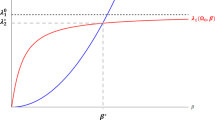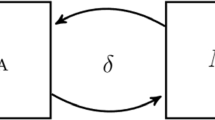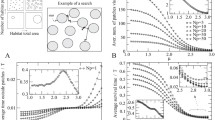Abstract
Many biological populations reside in increasingly fragmented landscapes, where habitat quality may change abruptly in space. Individuals adjust their movement behavior to local habitat quality and show preferences for some habitat types over others. Several recent publications explore how such individual movement behavior affects population-level dynamics in a framework of reaction–diffusion systems that are coupled through discontinuous boundary conditions. While most of those works are based on linear analysis, we study positive steady states of the nonlinear equations. We prove existence, uniqueness and global stability, and we classify their qualitative shape depending on movement behavior. We apply our results to study the question why and under which conditions the total population abundance at steady state may exceed the total carrying capacity of the landscape.






Similar content being viewed by others
References
Alqawasmeh Y, Lutscher F (2019a) Movement behaviour of fish, harvesting-induced habitat degradation and the optimal size of marine reserves. Theor Ecol. https://doi.org/10.1007/s12080-019-0411-x
Alqawasmeh Y, Lutscher F (2019b) Persistence and spread of stage-structured populations in heterogeneous landscapes. J Math Biol 78(5):1485–1527
Andow DA, Kareiva P, Levin SA, Okubo A (1990) Spread of invading organisms. Landsc Ecol 4(2/3):177–188
Arditi R, Lobry C, Sari T (2015) Is dispersal always beneficial to carrying capacity? New insights from the multi-patch logistic equation. Theor Popul Biol 106:45–59
Arditi R, Lobry C, Sari T (2018) Asymmetric dispersal in the multi-patch logistic equation. Theor Popul Biol 120:11–15
Cantrell RS, Cosner C (2003) Spatial ecology via reaction–diffusion equations. Wiley, New York
Cobbold C, Lutscher F (2014) Mean occupancy time: linking mechanistic movement models, population dynamics and landscape ecology to population persistence. J Math Biol 68:549–579
Courchamp F, Berec L, Gascoinge J (2008) Allee effects. Oxford University Press, Oxford
Crone EE, Brown LM, Hodgson JA, Lutscher F, Schultz CB (2019) Faster movement in nonhabitat matrix promotes range shifts in heterogeneous landscapes. Ecology. https://doi.org/10.1002/ecy.2701
Cruywagen GC, Kareiva P, Lewis MA, Murray JD (1996) Competition in a spatially heterogeneous environment: modelling the risk of spread of a genetically engineered population. Theor Popul Biol 49(1):1–38
DeAngelis D, Ni W-M, Zhang B (2016a) Dispersal spatial heterogeneity: single species. J Math Biol 72(1):239–254. https://doi.org/10.1007/s00285-015-0879-y
DeAngelis D, Ni W-M, Zhang B (2016b) Effects of diffusion on total biomass in heterogeneous continuous and discrete-patch systems. Theor Ecol 9(4):443–453. https://doi.org/10.1007/s00285-015-0879-y
Freedman HI (1980) Deterministic mathematical models in population ecology. Marcel Dekker, New York
Freedman HI, Waltman P (1977) Mathematical models of population interactions with dispersal. I: stability of two habitats with and without a predator. SIAM J Appl Math 32(3):631–648
Freedman HI, Shukla JB, Takeuchi Y (1989) Population diffusion in a two patch environment. Math Biosci 95(1):111–123
Langebrake J, Riotte-Lambert L, Osenberg CW, De Leenheer P (2011) Differential movement and movement bias models for marine protected areas. J Math Biol 64(4):667–696
Lewis MA, Petrovskii SV, Potts JR (2016) The mathematics behind biological invasions, vol 44. Springer, New York
Lou Y (2006) On the effect of migration and spatial heterogeneity on single and multiple species. J Differ Equ 223(2):400–426
Lutscher F, Musgrave J (2017) Behavioral responses to resource heterogeneity can accelerate biological invasions. Ecology 98(5):1229–1238
Lutscher F, Lewis MA, McCauley E (2006) The effects of heterogeneity on population persistence and invasion in rivers. Bull Math Biol 68(8):2129–2160
Maciel G, Cosner C, Cantrell RS, Lutscher F (2019) Evolutionary stable movement strategies in reaction–diffusion models with edge behavior. J Math Biol. https://doi.org/10.1007/s00285-019-01339-2
Maciel GA, Lutscher F (2013) How individual movement response to habitat edge effects population persistence and spatial spread. Am Nat 182(1):42–52
Maciel GA, Lutscher F (2015) Allee effects and population spread in patchy landscapes. J Biol Dyn 9(1):109–123
Ovaskainen O, Cornell S (2003) Biased movement at a boundary and conditional occupancy times for diffusion processes. J Appl Probab 40(3):557–580
Pacala SW, Roughgarden J (1982) Spatial heterogeneity and interspecific competition. Theor Popul Biol 21:92–113
Perko L (2001) Differential equations and dynamical systems. Springer, New York
Shigesada N, Kawasaki K, Teramoto E (1986) Traveling periodic waves in heterogeneous environments. Theor Popul Biol 30:143–160
Skellam JG (1951) Random dispersal in theoretical populations. Biometrika 38:196–218
Turchin P (1998) Quantitative analysis of movement. Sinauer Associates, Sunderland
Yurk B, Cobbold C (2018) Homogenization techniques for population dynamics in strongly heterogeneous landscapes. J Biol Dyn 12:171–193
Zhang B , Liu X, DeAngelis DL, Ni W-M, Wang G Geoff (2015) The effect of dispersal on total biomass in a patchy, heterogeneity system: analysis and experiment. Math Biosci 264:54–62
Zhang B, Kula A, Mack K, Zhai L, Ryce A, Ni W-M, DeAngelis D, Van Dyken JD (2017) Carrying capacity in a heterogeneous environment with habitat connectivity. Ecol Lett 20(9):1118–1128
Author information
Authors and Affiliations
Corresponding author
Additional information
Publisher's Note
Springer Nature remains neutral with regard to jurisdictional claims in published maps and institutional affiliations.
Frithjof Lutscher is grateful for funding from the Natural Sciences and Engineering Research Council of Canada for funding through the Discovery Grant Program (RGPIN-2016-04795) and for a Discovery Accelerator Supplement (RGPAS-2016-492872).
Appendix
Appendix
In this appendix, we provide the Proof of Lemma 5 and a discussion for why we cannot expect a similar result to hold when we choose the ecological (forward Kolmogorov) diffusion term. The proof is a slight adaptation from Lou (2006). We assume that u(x) is a positive solution of the steady-state equation with Fickian diffusion term and no-flux boundary condition:
We assume that all functions are sufficiently smooth and positive.
First, we divide both sides of the equation by u(x) and integrate by parts over the interval [0, L]. After applying the boundary conditions, we obtain:
Thus, the integral difference is positive, as claimed in the lemma.
Now, we consider the same equation, but with the Fickian diffusion term replaced by the ecological diffusion (or forward Kolmogorov) term (Turchin 1998):
We follow the same steps as above to find
We see that the right-hand side is not necessarily positive. Instead, some conditions on slope or curvature need to be satisfied for positivity. Since the shape of u depends on the shape of K and D, it is not obvious what these conditions are.
Rights and permissions
About this article
Cite this article
Zaker, N., Ketchemen, L. & Lutscher, F. The Effect of Movement Behavior on Population Density in Patchy Landscapes. Bull Math Biol 82, 1 (2020). https://doi.org/10.1007/s11538-019-00680-3
Received:
Accepted:
Published:
DOI: https://doi.org/10.1007/s11538-019-00680-3




